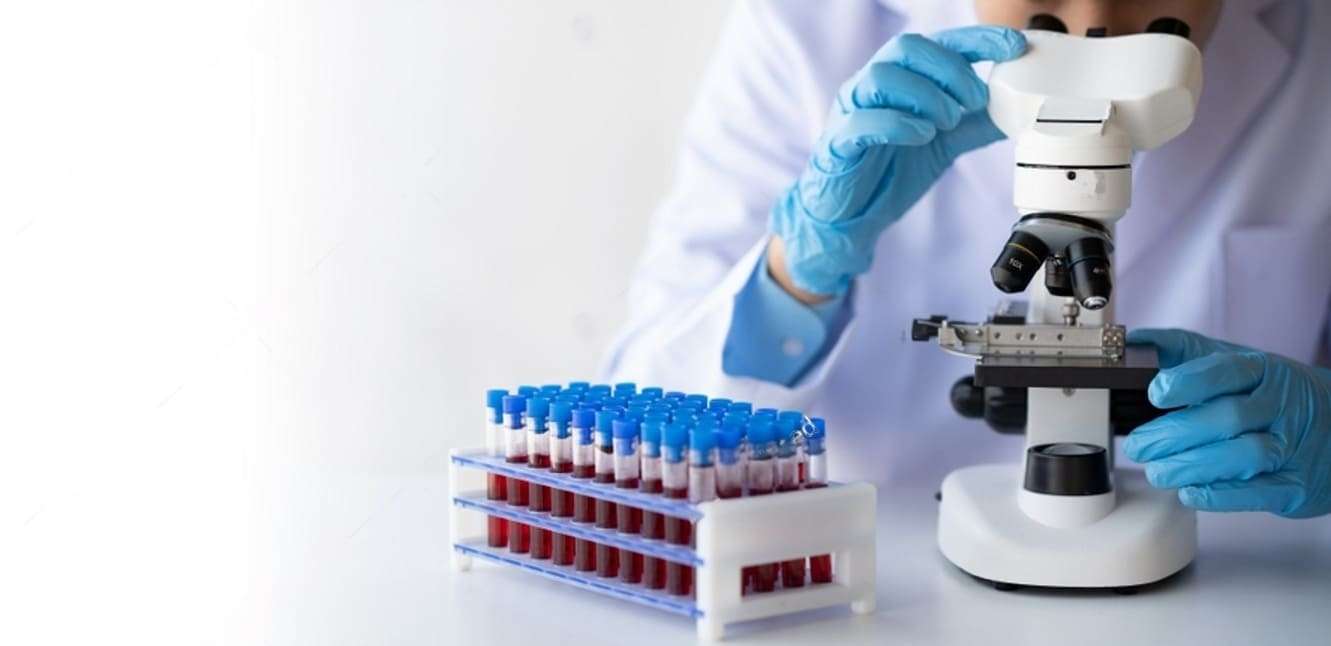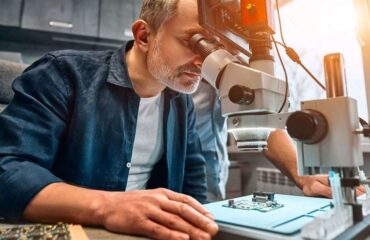Microscopes play a crucial role in biological and medical research in India, as they do globally. Their significance is multifaceted and spans various aspects of scientific inquiry and clinical practice. Here are some key roles that microscopes play in these fields:

Cellular and Molecular Biology
- Observation of Cell Structures: Microscopes allow researchers to study the intricate details of cellular structures, such as the nucleus, mitochondria, and cytoskeleton.
- Cell Behavior: Live-cell imaging helps in understanding cell dynamics, interactions, and responses to stimuli.
- Molecular Interactions: Fluorescence microscopy and confocal microscopy are essential for studying the interactions between molecules within cells, including protein-protein interactions and signal transduction pathways.
Genetics and Genomics
- Chromosome Analysis: Microscopes are used in karyotyping to identify chromosomal abnormalities and to study genetic disorders.
- Fluorescence In Situ Hybridization (FISH): This technique uses fluorescence microscopy to locate specific DNA sequences on chromosomes, aiding in genetic mapping and diagnostics.
Microbiology
- Identification of Microorganisms: Microscopes are fundamental for identifying bacteria, viruses, fungi, and parasites. This is essential for diagnosing infections and studying microbial ecology.
- Antibiotic Resistance: Observing the effects of antibiotics on bacteria helps in understanding mechanisms of resistance and developing new treatments.
Histology and Pathology
- Tissue Examination: Microscopes are used to examine tissue samples, helping pathologists diagnose diseases such as cancer, inflammatory conditions, and infections.
- Biopsy Analysis: Microscopic examination of biopsy samples is critical in identifying abnormal cells and determining the stage and type of disease.
Developmental Biology
- Embryo Development: Microscopes enable the study of embryonic development and morphogenesis, providing insights into congenital abnormalities and developmental processes.
- Stem Cell Research: Observing the behavior and differentiation of stem cells under the microscope is vital for regenerative medicine and therapeutic applications.
Medical Diagnostics
- Blood Analysis: Microscopes are used in hematology to analyze blood cells, diagnose anemia, leukemias, and other blood disorders.
- Cytology: Microscopic examination of cells from body fluids and tissues helps in diagnosing cancers and other diseases at an early stage.
Pharmacology and Drug Development
- Drug Testing: Microscopes are used to observe the effects of new drugs on cells and tissues, aiding in the screening and development of pharmaceuticals.
- Toxicology: Studying the toxic effects of substances at the cellular level helps in understanding their safety and potential side effects.
Educational Purposes
- Teaching and Training: Microscopes are essential tools in medical and biological education, helping students and trainees understand the microscopic anatomy and pathology of tissues and cells.
Public Health
- Disease Surveillance: Microscopes are used in laboratories for monitoring infectious diseases, understanding their spread, and developing strategies for prevention and control.
- Epidemiology: Studying pathogen samples at a microscopic level helps in tracking outbreaks and understanding disease epidemiology.
Microscopes are indispensable tools in biological and medical research in India, contributing significantly to advancements in health care, disease diagnosis, and scientific understanding. Their role in observing and analyzing biological samples at the cellular and molecular level is critical for both fundamental research and practical applications in medicine and public health. The continuous development of microscopy techniques and technologies further enhances their impact on scientific and medical progress.
What type of microscope will be used in the medical lab?
In a medical laboratory, various types of microscopes are used depending on the specific applications and requirements. Here’s an overview of the different types of microscopes commonly used in medical labs and their primary applications:
Light Microscope (Optical Microscope)
Types and Applications:
Compound Light Microscope:
- Application: Routine examination of blood smears, tissue sections, and microbial cultures.
- Usage: Identifying cell types, counting cells, and detecting abnormalities in cell morphology.
Stereomicroscope (Dissecting Microscope):
- Application: Examining the surface details of larger specimens.
- Usage: Used in surgery for examining tissue samples and for dissection purposes in pathology.
Phase Contrast Microscope
- Application: Observing live cells and unstained specimens.
- Usage: Useful for examining cell cultures, studying cell behaviors, and identifying cellular components without staining.
Fluorescence Microscope
- Application: Detecting specific biomolecules within cells and tissues.
- Usage: Immunofluorescence staining to detect antigens, DNA/RNA hybridization techniques, studying the localization of proteins, and diagnosing infections and autoimmune diseases.
Confocal Microscope
- Application: Producing high-resolution images and 3D reconstructions of specimens.
- Usage: Detailed examination of cell structures, tissues, and biofilms. Often used in research and advanced diagnostics.
Electron Microscope
Types and Applications:
Transmission Electron Microscope (TEM):
-
- Application: Examining ultrastructures within cells.
- Usage: Detailed study of organelles, viruses, and other sub-cellular structures.
Scanning Electron Microscope (SEM):
-
- Application: Producing detailed images of the surfaces of specimens.
- Usage: Analyzing the surface morphology of cells, tissues, and materials.
Polarizing Microscope
-
- Application: Identifying crystals and other birefringent materials.
- Usage: Used in pathology for detecting crystals in bodily fluids (e.g., gout diagnosis) and in dermatology for skin biopsies.
Digital Microscope
-
- Application: Capturing and analyzing digital images of specimens.
- Usage: Used for documentation, image analysis, telepathology, and educational purposes.
Automated and Semi-Automated Microscopes
-
- Application: High-throughput analysis and diagnostic purposes.
- Usage: Used in clinical settings for automated counting and analysis of blood cells, cytological screening (e.g., Pap smears), and microbial identification.
Conclusion
In medical laboratories, the choice of microscope depends on the specific diagnostic or research needs. Compound light microscopes are widely used for routine examinations, while fluorescence and confocal microscopes are used for more specialized applications, such as detecting specific proteins or nucleic acids within cells. Electron microscopes are employed for ultra-structural studies that require higher resolution. Additionally, digital and automated microscopes enhance efficiency and accuracy in clinical diagnostics. Ensuring the availability of a variety of microscopes allows medical labs to comprehensively address a wide range of diagnostic and research requirements.
